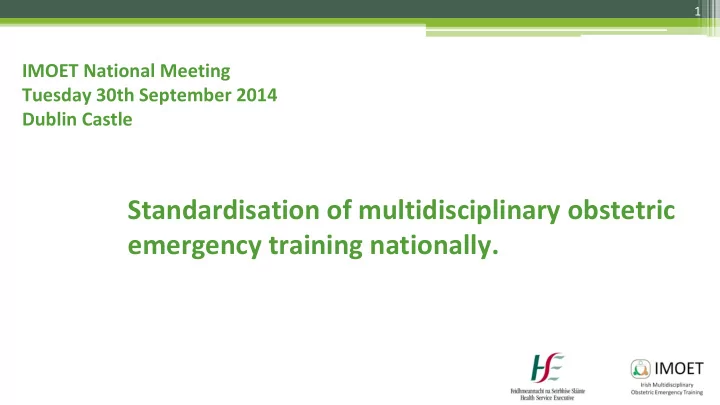

1 IMOET National Meeting Tuesday 30th September 2014 Dublin Castle Standardisation of multidisciplinary obstetric emergency training nationally.
Teamwork and Obstetric Emergencies Dr Niamh Hayes
ATM Return: • Aim: Get cash! Simple task… • Cash return first? • Card return first?
ATM Return: Cash return first: • Aim: Get cash!
ATM Return: Cash return first: • Aim: Get cash!
ATM Return: Card return first: • Aim: Get cash! > 10,000 transactions p.a. leave cash behind > € 1,000,000 p.a. … single bank R.O.I.
ATM Return: Card return first: • Aim: Get cash! Simple cognitive error… • Person capable of performing task safely • Has done so many times in the past • Faces significant personal consequences for error
Complexity of medical crisis?
Outline ▫ Context ▫ Definition ▫ Principles ▫ Metrics ▫ Resources ▫ Summary
Context: Scope of the problem 44,000 - 98,000 deaths p.a. IOM “To Err is Human” 1999
Context: Scope of the problem 600 - 1300 deaths p.a. IOM “To Err is Human” RoI?
Context: Scope of the problem 442 deaths 1999 Commercial aviation fatalities worldwide 1999
Causes? safe task completion technical competencies non-technical competencies procedural knowledge cognitive skills psychomotor skills social skills
Causes? • Non-technical failures cockpit resource management
Causes? • Non-technical failures crew resource management
Causes? • Non-technical failures crisis resource management
Definition • Crisis resource management: “The ability to translate medical knowledge to real world actions in the setting of an emergency” Howard SK et al. Anesthesia crisis resource management training : teaching anaesthesiologists to handle critical incidents. Aviation, space and environmental medicine 1992
Principles of CRM * EFFECTIVE COMMUNICATION * * LEADERSHIP AND MUTUAL RESPECT FOLLOWERSHIP * USE ALL SHARED DECISION AVAILABLE MAKING RESOURCES * SITUATIONAL AWARENESS Adapted from: Rall and Gaba, Miller’s Anesthesia 7th Edition *Teamwork elements from ACLS provider manual 2010, PROMPT provider manual
Principles of CRM EFFECTIVE COMMUNICATION Strategy of verification to make sure that CLOSED-LOOP the message sent was received and COMMUNICATION interpreted as intended
Principles of CRM EFFECTIVE COMMUNICATION STRUCTURED COMMUNICATION From HSE.ie and App Store (accessed 15th September 2014)
Principles of CRM National guideline for communication (handover) in maternity services in Ireland 295 pages!!!
Principles of CRM • Clear role/task allocation LEADERSHIP AND • Know limitations and ask for help early FOLLOWERSHIP • Mutual support/cross checking • Objective evidence (point of care testing) USE ALL • Human resources AVAILABLE • Cognitive aids (algorithms) RESOURCES
Principles of CRM What? Information gathering? So what? Understanding? What now? Anticipation? SITUATIONAL AWARENESS
Principles of CRM • “Power distance” (hierarchy) MUTUAL RESPECT • Treat input from other team members legitimately • “hint and hope”… SHARED DECISION • SBAR? MAKING • Critical language: CUS
Principles of CRM EFFECTIVE COMMUNICATION LEADERSHIP AND MUTUAL RESPECT FOLLOWERSHIP USE ALL SHARED DECISION AVAILABLE MAKING RESOURCES SITUATIONAL AWARENESS Adapted from: Rall and Gaba, Miller’s Anesthesia 7th Edition *Teamwork elements from ACLS provider manual 2010, PROMPT provider manual
Metrics • Domain/context-specific training interventions • Good face validity… • Evidence for construct validity (translational science)?
Metrics: Evidence for success? Southmead Hospital, Bristol (UK) • 51% reduction in Apgar 5 <7 • Infrastructural changes (protocols, props…) • 50% reduction in HIE • Regular in-house drills for all staff • 75% reduction in Erb’s palsy after shoulder dystocia • 40% reduction in median DDI for cord prolapse Draycott T et al. Does trianing in obstetric emergencies improve neonatal outcome? BJOG 2006;113:177-82 Draycott T et al. Improving neonatal outcome through practical shoulder dystocia training. Obstet Gynecol 2008;112:14-20 Siassakos D et al. Retrospective cohort study of DDI with umbilical cord prolapse: the effect of team training. BJOG 2009;116:1089-96 Siassakos D et al. The active components of effective training in obstetric emergencies. BJOG 2009;116:1028-32
Metrics: Evidence for success? BDIMC, Boston (US) • Teamwork course for all staff • 23% reduction in adverse obs events • 62% reduction in malpractice claims • Debriefings, improved handover • Labour staff > positive attitude to safety • Protocol development • Selected clinical drills Pratt S. Impact of CRM- based team training on obstetric outcomes and clinicians’ safety attitudes. Jt Comm J Qual Patient Saf 20 07;33:720-5 Siassakos D et al. The active components of effective training in obstetric emergencies. BJOG 2009;116:1028-32
Metrics: Evidence for success? Liverpool Women’s Hospital (UK) • Integrated risk management • 11% reduction in AE with suboptimal care • 50% reduction in Apgar 5 <4 • Patient involvement • 50% reduction in cord pH <7 • 86% reduction in Erb’s palsy • Regular team briefings and drills • Infrastructural improvements Scholefield H. Embedding quality improvement and patient safety at Liverpool Women’s NHS Foundation Trust. Best Pract Res Cli n Obstet Gynecol 2007;21:593- 607 Siassakos D et al. The active components of effective training in obstetric emergencies. BJOG 2009;116:1028-32
Metrics: Evidence for success? Rigshospitalet, Copenhagen (DK) • Clinical drills • Improved staff confidence scores & 45% reduction in midwifery staff sick leave • Streamlined protocols • Eclampsia and haemorrhage boxes Sorensen JL. The implementation and evaluation of a mandatory multi-professional obstetric skills training program. Acta Obstet Gynecol Scand. 2009;88(10):1107-17 Siassakos D et al. The active components of effective training in obstetric emergencies. BJOG 2009;116:1028-32
Metrics: Evidence for success? Evidence = association (not causation) Institution-level incentives to training and safety Relevant, in-house training culture Non-threatening training Self-directed infrastructural and assessment for entire changes (local solutions) workforce Realistic training tools (high Multiprofessional clinical fidelity) and teamwork training
Resources? Guideline Personnell Other Metrics O & G Ireland Obstetric Manikins Face validity satisfaction scores COMPASS training Midwifery Birthing Simulator Others? manual (HSE) NEWS guideline Anaesthesia Resus Manikin Unit dependent? (appendix 6, HSE) ISBAR app (iTunes & +++ android)
Practical skills & drills elements EFFECTIVE COMMUNICATION LEADERSHIP AND TTT elements MUTUAL RESPECT FOLLOWERSHIP Elements for certain scenarios USE ALL SHARED DECISION AVAILABLE MAKING RESOURCES SITUATIONAL AWARENESS
Looking forward • If you do only one thing when you return to your unit, use ISBAR
Recommend
More recommend